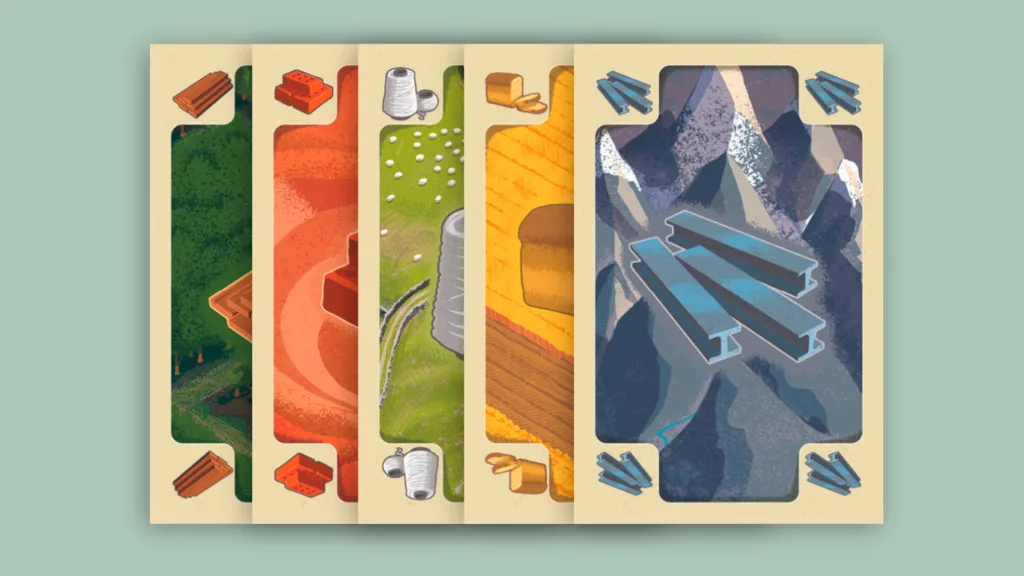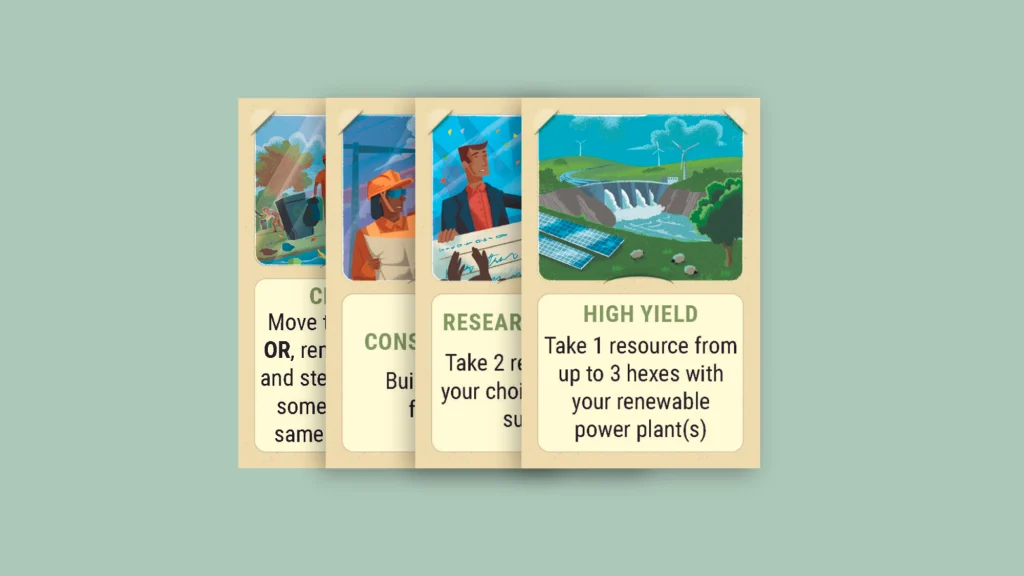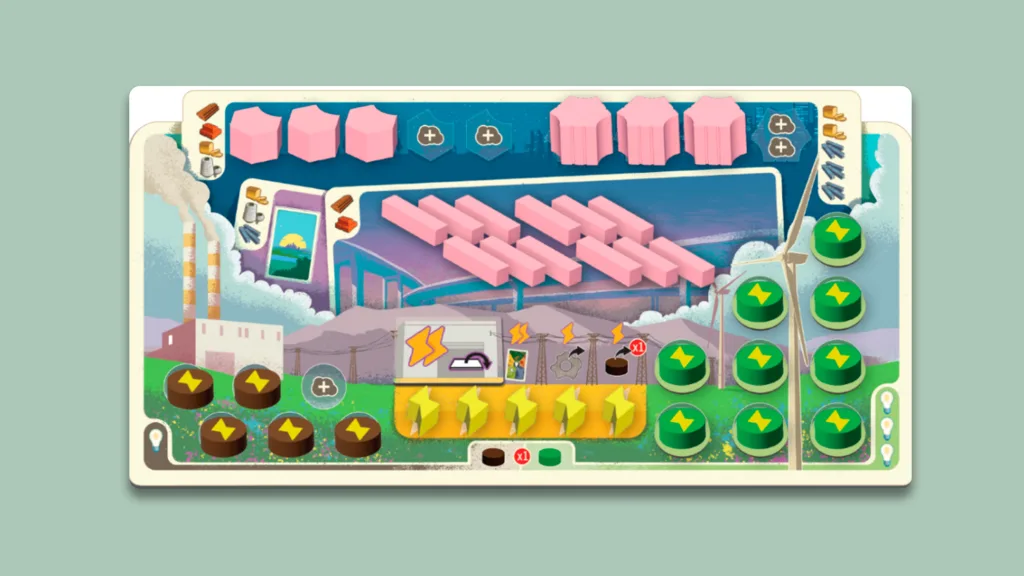The new Catan board game lets you pit fossil fuels against green energy

[ad_1]
Whether you’re a board game fan or just a hobbyist, you’re probably familiar with Catan. Released in 1995 under the name Settlers of Catan and created by Klaus Teuber, the game has sold over 40 million copies. It introduces the world to the fictional island of Catan, set in the year 900. Players are settlers on the uninhabited island, tasked with obtaining resources (wood, brick, ore, grain, and wool) and building settlements, cities, and roads.
Fast forward to the 21st century, and the island of Catan now faces new challenges and resources. In the face of a growing population, the island needs energy, and lots of it. In a soon-to-be-released edition called Catan: New energiesPlayers will be tasked with deciding whether to build fossil fuel power plants quickly and cheaply – which also increases pollution – or invest more slowly in renewable energy sources. The greenest player will not necessarily always win, but if pollution levels exceed a certain threshold, disaster strikes: game over for everyone, and the player who prioritized sustainability emerges victorious.
This collective effect reflects the unequal impacts of climate change: it is often island nations that produce much smaller amounts of greenhouse gas emissions that have to bear the brunt of climate catastrophe. In this way, the game reflects “the injustices in the world,” says Benjamin Teuber, managing director of Catan GmbH, the company that develops and licenses Catan products. He is also the son of Catan’s creator Klaus. Together, father and son designed Catan: New Energies, before Klaus’ death in April 2023.
But despite the unfairness of the game, there is also the opportunity to work together. Pollution levels limit the amount of resources produced on the island, hindering growth. Even if players first choose cheap fossil fuels, they may switch to renewable energy sources for positive effects. (Although there are no carbon capture methods in the game, building renewable energy sources reduces pollution, which is necessary to make the game mechanics work.)
“A lot of times, at the end of the game, you see everyone just freaking out like, ‘Man, we gotta save the world!’” Benjamin Teuber says. “But the pollution is already there, so what would you expect? And then maybe people start working together, and that’s a really nice effect that makes you think ‘If we all work together and everyone does their share, it can work, all it costs is us growing a little slower.’ ” “
How Catan came to confront climate change
Catan: New Energies is scheduled for release later in 2024, but it’s not the first time the game has confronted the topic of climate change. In 2011, the company released an expansion pack for its core game called Catan: Oil springsPresents a scenario of discovering oil on the island. “Oil is rare and its use does not come without a cost. The use of oil leads to pollution as well as climate-changing emissions, which bring with it the risk of coastal flooding and absolute disaster,” reads the expansion pack description. “With the discovery of oil in Catan, its residents face a new challenge: report Whether the public good is worth limiting the use of oil or whether the pursuit of victory is worth risking ruin.”
The idea for Catan: Oil Springs actually came from outside the company and the Teuber family. Eric Assadourian, then a senior fellow at the Worldwatch Institute, an environmental research organization, and Ty Hansen, an office director at the American Bar Association, designed the game as part of the institute’s “Transforming Cultures Project.” Normally, the company does not accept outside ideas, but it excluded these ideas. Teuber says it was so interesting that it inspired him and his father to think about energy consumption more broadly, and the idea of exploring fossil fuels versus renewable sources of electricity is in play.
But scaling up the energy idea was complicated, and new projects kept pushing it aside. “But in the time of Covid-19, my father and I found this idea again,” says Teuber. The world has changed since they first tried to address climate change: huge advances in environmental science and renewable energy, and even more urgently around highlighting and taking action on climate issues.

Challenges of the New Energies game
However, figuring out how the Catan: New Energies project would work logistically was difficult. At the core of this is a problem relevant to any board game, whether you’re inoculating against a pandemic, waging a world war, or settling an uninhabited island: the game is just a simplified simulation of the real world. “It’s always the same challenge to transform this enormous complexity of the outdoor environment into a board game,” says Teuber. “That’s been pretty much the challenge here, because on top of that, I’m not a scientist.”
Teuber once again enlisted the help of Asadourian to translate the complexities of climate science into the game. The playbook also delves into the realities of the energy transition that led to the climate crisis, pointing to the beginning of the use of fossil fuels in the industrial era, and noting how humans have released trillions of additional tons of carbon dioxide into the atmosphere since the Industrial Revolution.
When it comes to the actual gameplay of Catan: New Energies, “you have to know that it’s a simplified version of reality, of course,” Teuber says. “But at the heart of the matter, the idea is what matters most.” As the game’s author, he needed to make renewable energy more affordable so that he balanced the questions, “Do I want to grow fast, but at the expense of polluting the environment, or spend X more resources and grow slower?” More responsibly?” This resource becomes “research” cards. Players need more turns to collect those cards, making renewable energy growth more expensive and slower. Today, building and using renewable energy sources is less expensive than building coal or natural gas plants, but These are fairly recent developments: between 2009 and 2019, the price of solar electricity fell by 89%, thanks to huge leaps in technological advancement.

There is no carbon sequestration in the game, because it was difficult to add. Instead, building renewable energy combats pollution by putting “green codes” into effect. At the beginning of the game, when players have to draw a token to trigger an event, there are only brown tokens representing risks such as air pollution, environmental pollution, and floods. When players search for clean energy, green tokens are added to the mix. Drawing it instead of the brown token comes with bonuses, such as allowing players with more Renewable Power Plants to obtain additional resource cards. In fact, the carbon removal technology is in the works, it just needs more research to expand its scope, which is related to the game’s new resource card.

From the game to the real world
The environmentally friendly orientation extends to Catan: New Energies’ physical materials. Most English versions of Catan don’t actually use plastic pieces, and are assembled in the US Catan: New Power Materials are made from sustainably sourced wood and paper, and there’s no plastic shrink wrap around the game box; Just little stickers keep it sealed. Kelly Schmitz, director of brand development at Catan Studio, says the company considered every decision it made to minimize the impact of production. “Of course, that means it’s a little more expensive,” she says. (It is available for Pre-order for $69.99.) “It’s not a cheap game, it can’t be. I think that speaks to the point of the game, which is to make those conscious decisions wherever you can. Nothing’s going to be perfect, but it all adds up to something that’s better than it was before.” .
More and more games (both board and video) have addressed the topic of climate change. But since Catan is an older gaming brand with a built-in audience, it may have a unique opportunity to reach players who are discussing this issue. “The greater collective appeal of the Catan brand gives us a bigger voice. It gives us a bigger platform,” Schmitz says. “And obviously I think there’s a greater responsibility to use that platform to talk about important things.”
There’s no doubt that climate change is a serious topic, but Teuber stresses that the game is still fun. For him and his father, Catan: New Energies was designed to be an experience, not a lecture. “For me, it’s always been the best experience to learn while practicing, and that applies to this game as well,” he says. “You can play it, and you’ll get it intrinsically. If you play it 5 times, 10 times, you’ll discover: If you act like this, this will happen.
Teuber expects most players to skew the island of Catan quite heavily in their first game. “And I am among them,” he says. “This is still my first step.” But over time, your gameplay may surprise you. Teuber plays Catan: New Energies often with editors he calls “aggressive.” “The three of us, we always make the world go to hell.” But at some point, they tried to play differently, investing more in clean energy. One of those editors is from a region in Germany dedicated to clean energy, “and he said, ‘It’s actually true that I should do as my city does,’ and then we all played green,” Teuber says.
These ideas may extend beyond the board game. Teuber Katan says: The new energies sparked discussions with friends, such as riding a bike instead of driving a car on a given day. “The result of this match will not change the world. But maybe it will change your way of thinking, and later you can go and change the world.
[ad_2]
Source link



